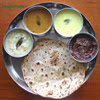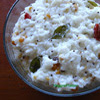I was searching web and sorting through the cook books that I borrowed from the library, to bake with bananas. I found a muffin recipe which seemed perfect in spite of the fact that I told myself earlier, no more making/baking banana muffins. I also found a banana loaf recipe which seemed equally good. I sat thinking for half an hour like Hamlet. Finally, the loaf got my vote. I prepared the batter. When it was time to pour in the loaf pan, I changed my mind and instead baked in a cake pan, so that I can have nice little squares (like a slice of cake) to eat instead of loaves. The following recipe (instructions) is from other source, for a banana loaf prepared in a 2 lb loaf tin. It was a nice, home made treat, tasting like a fruit cake.
This is my entry to Maheswari's AFAM - Banana event.

Ingredients:
Self-raising flour - 2 cups
Baking powder - 1/2 teaspoon
Salt - 3/4 teaspoon
Sugar - 1/2 cup
Butter - 1/2 cup
Milk --2 Tbsp
Sour cream -- 4 Tbsp
Medium sized bananas - 3
Raisins and dried cranberries - 1 cup
Grated orange peel - 1 tsp
Preheat the oven to 350 degree F.
Use a 900g/2 lb loaf tin, If you are planning to bake a loaf.
Sift together the flour, baking powder and salt.
Cream the butter and sugar until light and fluffy.
Add the sour cream and orange peel, beating well.
Mash the bananas, combine with the milk and add to the creamed mixture alternately with the flour mixture.
Beat until smooth after each addition. Stir in the raisins & dry cranberries.
Turn into the greased loaf tin. Bake for 45 to 50 minutes. Leave to cool in the tin for 10 minutes, and turn out onto a wire rack.
 Note:
Note:
This is the recipe which served me as a guideline. I made some changes based on the ingredients I had and also to suit my taste.
I added 2 cups of all purpose flour and a tsp of baking powder to substitute the 2 cups of self raising flour.
I added 4 tbsp of yogurt instead of the 4 tbsp of sour cream.
Dried fruits were my addition.
I baked the batter in a cake tin, cut it into small squares after cooling.
A little info about bananas:
When Maheswari asked to share the benefits of the fruit we knew about , it got me into thinking. The two things that came into my mind were these,
1. Bananas help to prevent constipation.
2. Banana is a healthy snack, which requires no packing , particularly when you are on the go.
Many of the Indians grow banana plants in their homes and from long time, not only bananas but also the flower, shoot and the leaves have been used in cooking and other purposes.
After googling, I got this information about the bananas and the plant.
India tops the chart in banana production. Globally, bananas rank fourth after rice, wheat and maize in human consumption.
Bananas are a valuable source of Vitamin A, Vitamin B6, Vitamin C, and potassium. It is reported that in Orissa, India, juice is extracted from the corm and used as a home remedy for the treatment of jaundice. In other places honey is mixed with mashed banana fruit and used for the same purpose.
The banana plant has long been a source of fibre for high quality textiles in Japan and Nepal. Banana fibre is also used in the production of banana paper.
Post a Comment











































